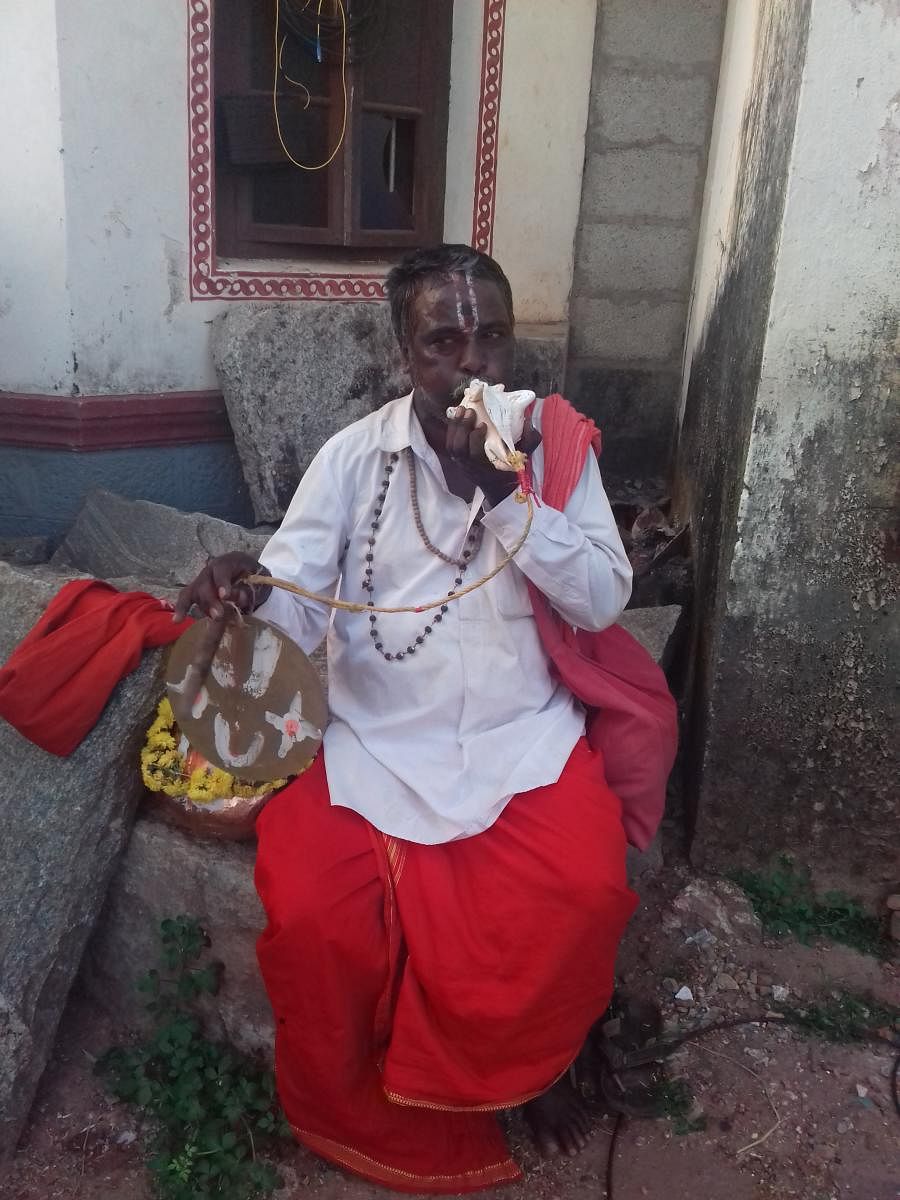
The sound of the conch is louder than the traffic. I go to the door with a bowl of rice kernels and a coconut. As expected, it’s the dasayya, the roving mendicant who shows up every year during the rainy month of Shravana.
“Lakshmi Ramana Govinda!” he says, and I complete it with, “Govinda,”as I pour the rice kernels into his copper bowl. “You are late this year, dasayya,” I say. He says he was busy with his son’s engagement.
I remember the little boy who accompanied his father every Shravana Saturday morning. He and his friends sang the same refrain as his father did, and received alms and a Parry’s sweet in each of their shiny brass pots.
“What does he do now?”
“He finished PU, and now drives heavy vehicles. After me, he will be the dasayya,” says Venkatappa.
Venkatappa, a Dalit, comes from a family lineage of dasayyas. Although he has a job as a peon in the government school in the village near our suburb, he continues to carry on this calling.
A dasayya wears a white robe, red cummerbund, dhoti and turban. He carries a conch shell, a copper begging bowl (bonaasi), a gong and striker, and a long horn called banaki.
He wears a garland of tulasi beads and a medallion of the Lord of the Seven Hills. His forehead is adorned with the three vertical lines of the Vaishnavite order.
He goes from house to house barefoot, blowing his conch and asking for alms in the name of the lord.
On one of the Saturdays of Shravana, the dasayya hosts a banquet for all the members of his village. The alms he has gathered is cooked and served after offering it to the deity.
According to Diwan Bahadur LKA Iyer, (Mysore Tribes and Castes, published 1928), a dasayya plays an important role as a priest. He is invited to perform life-cycle rites such as naming ceremony and rituals concerning coming-of-age of girls, and death.
Dasayyas are itinerant mendicants of southern Karnataka devoted to Lord Vishnu. The order of dasayya is open to all men.
A guru dasayya hosts the initiation of a young bachelor by branding his shoulders with the conch and chakra symbols and whispering a mantra in his ear.
According to history, this Vaishnavite order was started by Acharya Ramanuja in the 11th century. Madhva saint Narahari Teertha encouraged its growth. In the 15th century, Vyasa Teertha, the guru of King Krishnadevaraya of Vijayanagara, made it mandatory for a householder to offer food grains to dasayyas.
This custom was probably started to instill a sense of mutual reciprocity in both the parties. The mendicants were encouraged to move from place to place and sing devotional songs in praise of Venkataramana or Vittala, and narrate moral stories from the epics. Also belonging to the Bhakti movement, they were authorised to perform life-cycle rites of the so-called ‘backward’ castes with a simple mantra.
An extraordinary celebration which a dasayya officiates is the Kariyanna-Kenchanna jatre.
Kariyanna and Kenchanna are assigned to history as the guards at the Lord Ranganatha temple at Gavi Rangaswamy Hill near Channapatna, who were transformed into masks to guard the temple eternally. You can see the first painted masks in a cave there.
The celebration is held by a village family after a trip to Tirupati. Two large wooden masks, one painted in black and the other painted in red, are used.
The dasayya first worships the deity with the leaves of the Indian laburnum tree. After offering jackfruit to the deity, he calls out, “Holia!” pushing the crowd into action. The men holding the masks get into a trance, dance and run, followed by others. They come out of it after eating the jackfruit.
The ceremony is followed by a sumptuous feast for the village.